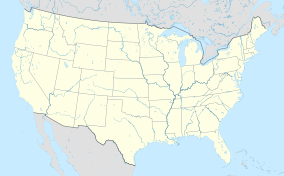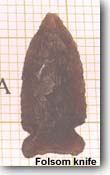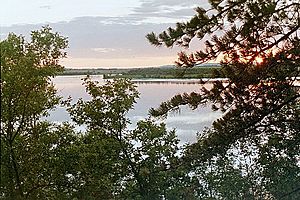Lake Ilo National Wildlife Refuge facts for kids
Quick facts for kids Lake Ilo National Wildlife Refuge |
|
|---|---|
|
IUCN Category IV (Habitat/Species Management Area)
|
|
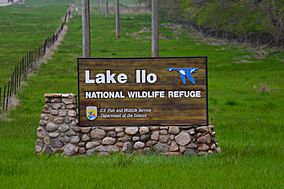 |
|
| Location | Dunn County, North Dakota, USA |
| Nearest city | Dunn Center, ND |
| Area | 4,034 acres (16 km2) |
| Established | 1939 |
| Governing body | U.S. Fish and Wildlife Service |
| Website | Lake Ilo National Wildlife Refuge |
Lake Ilo National Wildlife Refuge (NWR) is a special place in North Dakota, USA. It is managed by the U.S. Fish and Wildlife Service. This refuge includes Lake Ilo, plus many surrounding wetlands and grasslands. It provides a home for hundreds of different birds, fish, and mammals. About 16 inches (40 cm) of rain falls here each year. This helps the prairie ecosystem to grow and thrive.
Scientists have found many ancient tools and items at Lake Ilo NWR. These items were left by Paleo Indian people. They lived in this area more than 10,000 years ago. These discoveries help us learn about their lives. This makes the refuge important for both nature and human history.
Contents
History of Lake Ilo
People have lived in the Lake Ilo area for about 11,000 years. Since 1989, over 58,000 stone tools have been found here. Many of these tools are made from a special stone called Knife River Flint. This stone is strong but easy to shape. Early people used it to make spear points and other tools. This type of stone is mostly found in western North Dakota. Tools made from it have been found far away, even in New York and New Mexico.
The area where Lake Ilo NWR is located was one of the last parts of the Great Plains to be settled. In the 1930s, the Dust Bowl brought dry weather and dust storms. There were no large bodies of water in this part of North Dakota. So, in 1936, the U.S. Government hired local people to build a dam. This dam would create a steady water supply. The dam was finished in 1938. The next year, U.S. President Franklin D. Roosevelt made the new lake and its surroundings a National Wildlife Refuge.
In the late 1980s, the dam on Lake Ilo needed repairs. So, in 1989, the lake was partly drained by 7 feet (2 meters). A new concrete dam was built. Soil from the old dam was used to create two small islands. These islands help waterfowl to build nests. When the lake was drained, many ancient tools were found. Scientists also found a Tipi ring, which is a circle of stones from an old Native American camp. By 1994, over 58,000 items had been discovered. These items help us understand how the first people lived here. Scientists also found bones of animals that are now extinct. This helps us learn about the animals that lived here after the ice age.
Nature at Lake Ilo
Where Animals Live
Lake Ilo NWR has about 2,650 acres (10.7 km2) of grassland prairie. Lake Ilo itself is a man-made lake that covers 1,240 acres (5.0 km2). The prairie here gets only about 16.8 inches (42 cm) of rain each year. So, the lake is very important. It provides water and nesting spots for hundreds of migratory waterfowl and other birds. The refuge also has more than two dozen smaller wetlands.
The natural habitat here is Short grass prairie. This is similar to the steppe in Asia. But because it gets a bit more rain, it has more trees. Since the lake was created in the 1930s, Lake Ilo NWR now has more forested areas. These areas offer more nesting places for songbirds and small mammals.
Summers in North Dakota are usually pleasant. Temperatures are often around 70s °F (25 °C). Nights cool down to the 50s °F (7 °C). Winters are windy and can be very cold. Temperatures can drop to -56 °F (-49 °C). On average, two blizzards happen here each year.
Amazing Animals and Plants
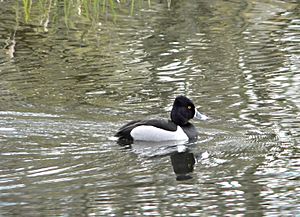
More than 226 types of birds have been seen at Lake Ilo NWR. This includes the endangered whooping crane. It also includes the threatened bald eagle and piping plover. During fall migrations, up to 100,000 waterfowl visit the refuge. You might see Canada geese, mallards, northern pintails, and blue-winged teal. Other birds like double-crested cormorants and great blue herons are also common. Most birds are here during spring and fall. But some bird species stay all year.
Many mammals live here too. You might see white-tailed deer, badgers, skunks, beavers, and raccoons. Less common mammals include the pronghorn, mule deer, and coyote. In total, 36 mammal species have been recorded. The refuge is also home to three types of amphibians and six types of reptiles. These include the tiger salamander, common snapping turtle, bull snake, and chorus frog. Lake Ilo has 11 types of fish. Some examples are Northern pike, yellow perch, and black crappie.
Things to Do at the Refuge
You can go fishing on Lake Ilo almost all year. Fishing is not allowed in April. Small motorboats are allowed, but they must go slowly. Some wetland areas might be closed to fishing in spring and fall. This helps protect nesting birds.
You can watch wildlife from a 1-mile (1.6 km) nature trail. This trail is on the north shore of Lake Ilo. You can also view wildlife from the gravel roads. Some wetland areas on the southwest side of the lake are closed to people all year.
The refuge has several displays about archeology. There is also a rebuilt Tipi ring near the nature trail entrance. At the Lake Ilo dam, you can find a display about the dam's history. This includes its building in the 1930s and repairs in the 1990s. On the north shore of the lake, there is a boat ramp and a picnic area for visitors.
The refuge is located 1 mile (1.6 km) west of Dunn Center, North Dakota. It is on Highway 200. The refuge is only open during the daytime.
How the Refuge is Managed
Lake Ilo NWR is part of the Audubon National Wildlife Refuge Complex. It is one of many refuges managed from the main office at Audubon National Wildlife Refuge. A small team works to maintain the refuge. Lake Ilo NWR is one of over 540 places managed by the U.S. Fish and Wildlife Service. This agency is part of the U.S. Department of the Interior. The main goal of the refuge is to protect the homes of different plants and animals.


